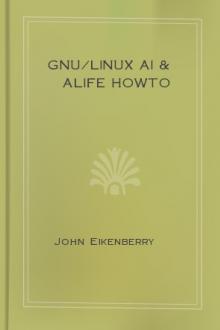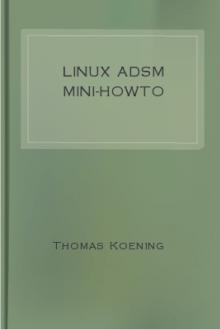GNU/Linux AI & Alife HOWTO, John Eikenberry [best books to read for self development TXT] 📗

- Author: John Eikenberry
- Performer: -
Book online «GNU/Linux AI & Alife HOWTO, John Eikenberry [best books to read for self development TXT] 📗». Author John Eikenberry
(ian@ohm.york.ac.uk).] with each cell; and
� local interactions only, since it is impossible to construct
automata that contain any global control or references to
global variables.
CLIG
� Web site: www.ags.uni-sb.de/~konrad/clig.html
CLIG is an interactive, extendible grapher for visualizing
linguistic data structures like trees, feature structures,
Discourse Representation Structures (DRS), logical formulas etc.
All of these can be freely mixed and embedded into each other.
The grapher has been designed both to be stand-alone and to be
used as an add-on for linguistic applications which display
their output in a graphical manner.
Corewar VM
� Web site: www.jedi.claranet.fr/
This is a virtual machine written in Java (so it is a virtual
machine for another virtual machine !) for a Corewar game.
Dunce
� Web site: www.boswa.com/boswabits/
Dunce is a simple chatterbot (conversational AI) and a language
for programming such chatterbots. It uses a basic regex pattern
matching and a semi-neural rule/response firing mechanism (with
excitement/decay cycles).
Dunce is listed about halfway down the page.
EcoSim
� Web site: www.offis.de/projekte/projekt.php?id=140
NOTE: the above web site has info on EcoSim but no code to
download.
In EcoSim an ecosystem is described by all static and dynamic
properties of the individuals involved in the system as well as
time varying properties of the environment. Individuals change
their state over time or due to internal and external events.
The environment is also defined via dynamic objects which can
change. Supports on the fly analysis and animation of generated
data. It is a C++ class library designed to support individual-oriented modelling and simulation of ecological systems.
Evo
� Web site: omicrongroup.org/evo/
Evo is a software development framework that allows developers
to build complex alife simulations. Using Evo, researchers can
easily build systems of independent agents interacting with one
another and with their environment. Evo implements biological
operators such as genetic recombination and mutation to evolve
the behavior of agents so that they are more adapted to their
environment.
IDEAL
� Web site: yoda.cis.temple.edu:8080/ideal/
IDEAL is a test bed for work in influence diagrams and Bayesian
networks. It contains various inference algorithms for belief
networks and evaluation algorithms for influence diagrams. It
contains facilities for creating and editing influence diagrams
and belief networks.
IDEAL is written in pure Common Lisp and so it will run in
Common Lisp on any platform. The emphasis in writing IDEAL has
been on code clarity and providing high level programming
abstractions. It thus is very suitable for experimental
implementations which need or extend belief network technology.
At the highest level, IDEAL can be used as a subroutine library
which provides belief network inference and influence diagram
evaluation as a package. The code is documented in a detailed
manual and so it is also possible to work at a lower level on
extensions of belief network methods.
IDEAL comes with an optional graphic interface written in CLIM.
If your Common Lisp also has CLIM, you can run the graphic
interface.
Illuminator
� Web site:
documents.cfar.umd.edu/resources/source/illuminator.html
Illuminator is a toolset for developing OCR and Image
Understanding applications. Illuminator has two major parts: a
library for representing, storing and retrieving OCR
information, heretofore called dafslib, and an X-Windows “DAFS”
file viewer, called illum. Illuminator and DAFS lib were
designed to supplant existing OCR formats and become a standard
in the industry. They particularly are extensible to handle more
than just English.
The features of this release:
� 5 magnification levels for images
� flagged characters and words
� unicode support — American, British, French, German, Greek,
Italian, MICR, Norwegian, Russian, Spanish, Swedish,
keyboards
� reads DAFS, TIFF’s, PDA’s (image only)
� save to DAFS, ASCII/UTF or Unicode
� Entity Viewer - shows properties, character choices, bounding
boxes image fragment for a selected entity, change type,
change content, hierarchy mode
Symbolic Probabilistic Inference (SPI)
� FTP site: ftp.engr.orst.edu/pub/dambrosi/spi/
� Paper (ijar-94.ps): ftp.engr.orst.edu/pub/dambrosi/
Contains Common Lisp function libraries to implement SPI type
baysean nets. Documentation is very limited. Features:
� Probabilities, Local Expression Language Utilities,
Explanation, Dynamic Models, and a TCL/TK based GUI.
TIN
� Web site: www.jetlag.demon.nl
This program simulates primitive lifeforms, equipped with some
basic instincts and abilities, in a 2D environment consisting of
cells. By mutation new generations can prove their success, and
thus passing on “good family values”.
The brain of a TIN can be seen as a collection of processes,
each representing drives or impulses to behave a certain way,
depending on the state/perception of the environment ( e.g.
presence of food, walls, neighbors, scent traces) These behavior
process currently are : eating, moving, mating, relaxing,
tracing others, gathering food and killing. The process with the
highest impulse value takes control, or in other words: the tin
will act according to its most urgent need.
Ummon
� Web site: www.spacetide.com/projects/ummon/
Ummon is an advanced Open Source chatterbot. The main principle
of the bot is that it has no initial knowledge of either words
or grammar; it learns everything “on the fly.” Numerous AI
techniques will be explored in the development of Ummon to
achieve realistic “human” communication with support for
different, customizable personalities.
8.2. Dead projects.
EMA-XPS - A Hybrid Graphic Expert System Shell
� Web site: www.iai.uni-wuppertal.de/EMA-XPS/
EMA-XPS is a hybrid graphic expert system shell based on the
ASCII-oriented shell Babylon 2.3 of the German National Research
Center for Computer Sciences (GMD). In addition to Babylon’s AI-power (object oriented data representation, forward and backward
chained rules - collectible into sets, horn clauses, and
constraint networks) a graphic interface based on the X11 Window
System and the OSF/Motif Widget Library has been provided.
PDKB
� Web site: lynx.eaze.net/~pdkb/web/
� SourceForge site: sourceforge.net/projects/pdkb
Public Domain Knowledge Bank (PDKB) is an Artificial
Intelligence Knowledge Bank of common sense rules and facts. It
is based on the Cyc Upper Ontology and the MELD language.
QUANT1
� Web site: linux.irk.ru/projects/QUANT/
This project seems to have gone proprietary. The only trace I
can find via google is at .
QUANT/1 stands for type QUANTifier. It aims to be an alternative
to Prolog-like (Resulutional-like) systems. Main features
include a lack of necessity for eliminating Quantifiers,
scolemisation, ease of comprehension, large scale formulae
operation, acceptance of nonHorn formulaes, and Iterative
deeping. The actual library implemented in this project is
called ATPPCF (Automatic Theorem Prover in calculus of
Positively Constructed Formulae).
ATPPCF will be a library (inference engine) and an extension of
the Predicate Calculus Language as a new logical language. The
library will be incorporable in another software such as TCL,
Python, Perl. The engine’s primary inference method will be the
“search of inference in language of Positively Constructed
Formulas (PCFs)” (a subset of Predicate Calculus well translated
in both directions). The language will be used as scripting
language to the engine. But there will be possibility to replace
it with extensions languages of main software.
RobocodeNG
� Web site: robocodeng.sourceforge.net
Merged together with original “” as of version 1.1.
Extension of Robocode, the battling bot AI programming game.
Like its parent, it is written in Java and meant as a learning
environment.
Sulawesi
� Web site: wearables.essex.ac.uk/sulawesi/
A framework called Sulawesi has been designed and implemented to
tackle what has been considered to be important challenges in a
wearable user interface. The ability to accept input from any
number of modalities, and perform if necessary a translation to
any number of modal outputs. It does this primarily through a
set of proactive agents to act on the input.
TresBel
� Abstract: iridia.ulb.ac.be/Projects/imple.html
� Direct Download:
ftp://iridia.ulb.ac.be/pub/hongxu/software/TresBel.tar.Z
This project seems to have been superseded by “”.
Libraries containing (Allegro) Common Lisp code for Belief
Functions (aka. Dempster-Shafer evidential reasoning) as a
representation of uncertainty. Very little documentation. Has a
limited GUI.





Comments (0)